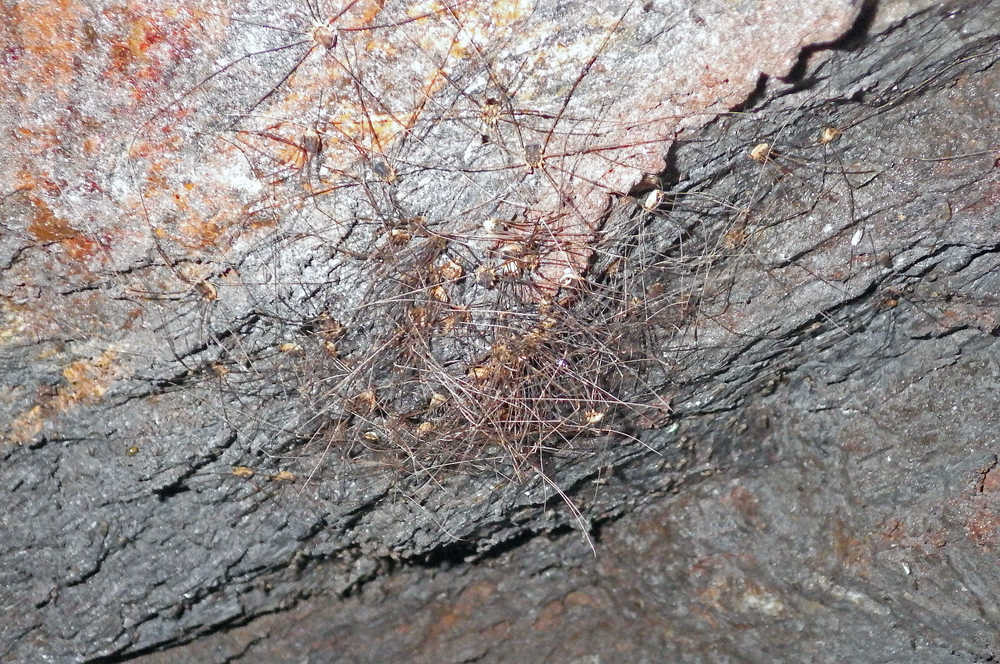Wonderful snow! Brightening our short December days; under that full moon, it was spectular.
All that glorious snow drew me out, day after day, looking for little stories writ there. There were all the usual perpetrators: deep, winding furrows made by wide-bodied, peripatetic porcupines, lots of snowshoe hares (especially near the visitor center), a mink bounding over a frozen rivulet, red squirrels tramping back and forth between trees, a deer or two — or lots in some places, an ermine, some good otter slides, a few voles and shrews (and a couple of mysteries that I shall gloss over).
There were also a few real highlights. Out near Peterson Creek, after watching a hungry dipper searching for some open water, my friend glanced up and spotted something odd-looking about 10 feet up a spruce, right next to the trunk. This looked like a mushroom, stuck in a tuft of twigs. Really? So my friend climbed up, to look more closely. Indeed, not just one, but five or six mushrooms were wedged in a tight stack, in among the twigs. Ha! A squirrel cache. Red squirrels are known to store mushrooms in dry places, such as the tops of well-drained stumps or logs (but cones are usually stored in damp places, so they don’t open and drop the seeds). This squirrel clearly thought that the twiggy tuft was good enough to warrant stashing several valuable food items there.
The sloping base of a huge spruce in Amalga Meadows had been an active site. Small prints of a critter that could bound six or eight inches decorated the trunk up about three feet, as well as all the surrounding snowy ground. Hmm, not a vole, which usually scuttles along, nor a jumping mouse, which hibernates, but probably a deer mouse.
We looked out over the wind-swept open area of the meadow, where the snow had been draped over tussocks and small conifers. We saw immediately that these looked like sea lions lunging up from the water. There was a big, thick-necked bull, and a whole squadron of juveniles, not far behind. No great imagination needed to provide some sound effects as well!
Some friends like to explore old mines in the Juneau area and recently explored one near the base of Thunder Mountain. The adit was barricaded by stout icicles, but a few were persuaded to break, allowing human entrance. Not too far back in the tunnel, observers spotted a number of harvestmen (aka daddy longlegs) on the wall. Near the end of the 80-foot adit, many of these were clustered into a close group, with their long legs sticking out in all directions.
Harvestmen are related to spiders, but not very closely. In contrast to spiders, they are not predatory; they feed chiefly on bits of plant and animal debris. They are also not venomous and cannot bite you with their weak jaws. They may get protection from deep cold outside temperatures in mine adits. They are often gregarious, gathering in bunches, but why? One suggestion is that they are behaving like what is known as a “selfish herd.” Each animal tries to put as many others as possible between itself and the edge of the group, where the risk of predation is highest. For these harvestmen, the most likely predators are spiders, or possibly mice.
These old adits are also a favorite refuge of porcupines. They find protection from the most severe cold outside, as well as the drenching rains of autumn. They are also generally free of harassment by dogs and humans. Some adits show evidence that porcupines have used them for a long time.
One day in late December, I wandered along the western shore of Mendenhall Lake. Some folks were walking out on the lake ice, but that seemed a bit risky to me. All along the upper beach, near the edge of the woods, I found places where deer had come out onto the beach a short way and then circled back into the woods. That seemed to be an odd thing for deer to do. One more mystery!
In mid-December, Parks and Rec hikers headed for a favorite destination in the meadows along Lawson Creek. As we traipsed along on snowshoes near the Treadwell Ditch, a small bird suddenly popped up and landed on a snow-covered conifer. A dipper! Perhaps as surprised as we were — perching neck-deep in white fluffy snow, it looked us over. Then it “swam” up through deep snow on a drooping branch, checked us out again, and finally winged it way back toward the creek. What a treat!
• Mary F. Willson is a retired professor of ecology.

